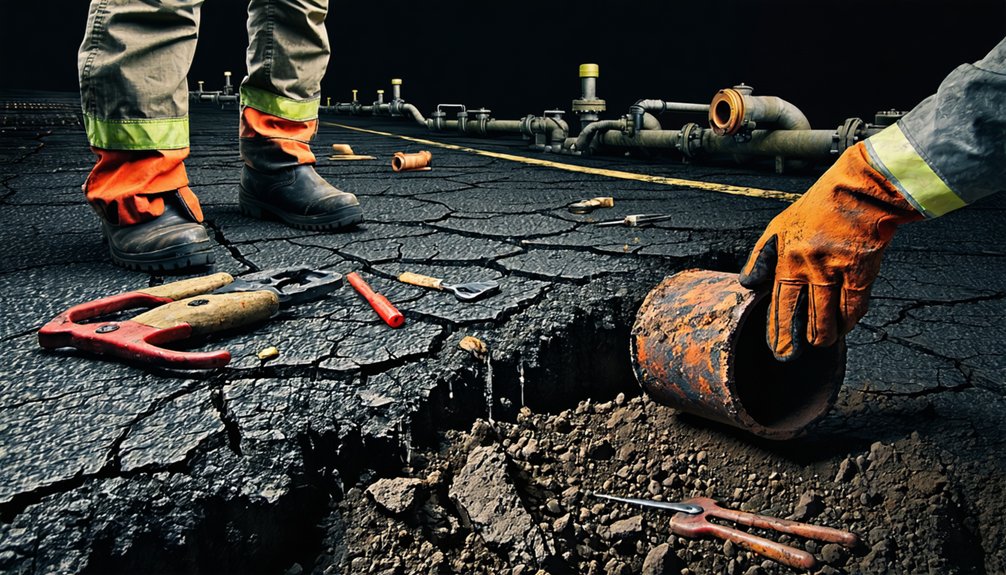Three primary factors notably influence sewer replacement costs: labor costs, material selection, and excavation challenges. Labor costs can vary widely based on job complexity and pipe depth. Material choice affects both initial expenses and long-term maintenance needs, with options ranging from economical PVC to more expensive cast iron. Excavation costs fluctuate depending on access difficulties and the presence of existing utilities. Understanding these elements is essential for effective budgeting and efficient project management, leading to further insights on cost optimization.
Labor Costs and Their Impact
Although labor costs for sewer line replacement can vary considerably, they play an essential role in determining the overall expense of the project. Ranging from $4,000 to $25,000, these costs are heavily influenced by the complexity of the job, the length of the damaged pipe, and the job's location. Skilled labor is vital, particularly for underground plumbing and heavy equipment operation, as these tasks require experienced professionals capable of maneuvering challenges. Moreover, the depth of the sewer line greatly impacts labor expenses; deeper installations necessitate specialized equipment and increased effort. Accessibility issues, such as landscaping or structural obstructions, can additionally elevate labor costs due to the need for labor-intensive techniques. Hiring experienced professionals guarantees adherence to local codes and regulations, ultimately fostering quality work and helping to prevent costly mistakes that could arise from inadequate execution.
Material Selection and Its Cost Implications
Material selection considerably influences the overall cost of sewer line replacement, impacting both initial expenditures and long-term maintenance implications. The choice of material affects not only the upfront costs but also the longevity and maintenance needs of the sewer line. PVC, the most economical option, ranges from $0.50 to $2.00 per linear foot and boasts a lifespan exceeding 100 years with minimal maintenance. In contrast, cast iron pipes, priced between $3.00 and $8.00, may incur higher maintenance costs due to corrosion susceptibility. ABS pipes, while similar to PVC, cost between $2.00 and $3.50 per linear foot but offer better impact resistance. Additionally, trenchless methods can optimize material selection, minimizing restoration expenses.
| Material | Cost Range (per foot) | Longevity |
|---|---|---|
| PVC | $0.50 – $2.00 | 100+ years |
| Cast Iron | $3.00 – $8.00 | 50 – 100 years |
| ABS | $2.00 – $3.50 | 50 – 80 years |
Excavation and Accessibility Challenges
When considering sewer line replacement, excavation and accessibility challenges play a critical role in determining overall project costs. Excavation costs can vary greatly, ranging from $50 to $250 per foot, influenced by factors such as the depth of the pipe and the complexity of excavation. Accessibility challenges, particularly in urban settings, often complicate these efforts, as existing utilities and infrastructure may necessitate specialized equipment and skilled labor, thereby increasing labor costs and project duration. The presence of tree roots can further complicate excavation, requiring additional labor for root removal and incurring higher restoration costs. Effective planning and assessment of the excavation site are paramount to identifying potential accessibility issues early, allowing homeowners to budget appropriately for unexpected expenses. Ultimately, understanding these factors is essential for accurately estimating sewer replacement costs and ensuring a smooth project execution.
Frequently Asked Questions
Why Is Replacing a Sewer Line so Expensive?
Replacing a sewer line incurs significant expenses due to various factors. Labor fees can vary drastically based on job specifics, while excavation expenses depend on depth and location. Material choices, such as pipe materials, further influence costs, with trenchless technology offering potential savings. Additionally, the permitting processes can add unforeseen charges. Home insurance may cover some costs, but overall, the combination of these elements contributes to high replacement costs in sewer line projects.
What Is the Cheapest Way to Replace a Sewer Line?
In the domain of sewer line replacement, finding the most economical method resembles traversing a labyrinth. Utilizing trenchless technology, such as pipe bursting, can considerably reduce costs, ranging from $80 to $250 per foot, while minimizing environmental impact. Additionally, comparing materials like PVC against traditional options can yield savings. Seeking multiple contractor quotes and exploring financing options guarantees an informed decision. Maintaining the system proactively further mitigates future expenses, liberating homeowners from financial strain.
How Much Does It Cost to Replace 50 Feet of Sewer Line in California?
The cost to replace 50 feet of sewer line in California involves a detailed cost breakdown. Key factors include replacement materials and labor expenses, which can fluctuate based on pipe types and location impact. Permit fees add an additional layer of expense, while excavation costs may vary depending on property access. Environmental regulations may also influence overall expenditures, including warranty options for the chosen materials, ultimately affecting the project's total financial commitment.
What Costs Are Involved in a Sewer System?
In the United States, approximately 40% of sewer systems require significant repairs or replacement. The costs associated with a sewer system encompass installation costs, material prices, and labor rates. Maintenance expenses can arise from ongoing inspections and necessary repairs, while permitting fees and equipment rentals add to initial outlays. Environmental considerations and the potential impact on property value further complicate financial assessments, necessitating a thorough analysis of all associated expenses.



